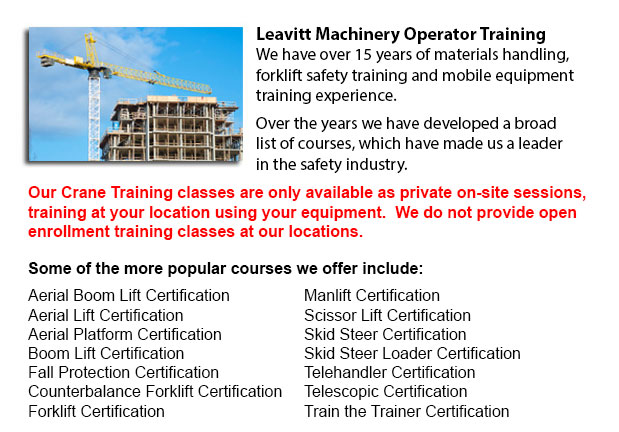
Overhead Crane Operator Training Ottawa - The program teaching overhead crane operator training has been designed particularly to instruct trainees on the fundamentals of pre-shift checks and overhead crane/sling operation. The programs are instructed by professional trainers and consultants. Well-trained workers are more productive and efficient, which saves on costs connected with merchandise damage, property damage, and accidents due to the utilization of incorrect operating procedures. Our overhead crane certification is customized for workers who have literacy barriers, reducing certification time by 50 per cent.
The overhead crane has been made to be used doing repetitive hoisting activities. This particular type of crane can be used in numerous capacities. They may be utilized for specialized hoisting jobs such as removing or installing major plant machinery.
In order to safely utilize an overhead crane, employees need to employ safe rigging practices. This needs both practice and knowledge. The load should be rigged correctly to be able to guarantee its stability when hoisted. Before beginning a lifting job, it must be determined that the crane is suitable for the job, with right lift, capacity and travel. The crane must be subjected to a thorough visual and physical inspection before utilization. The capacity of all equipment, including the slings, hardware and rope, must never go beyond load weight capacities.
Prior to utilizing the rigger should know what sling is right for every lift and be able to check the rigging hardware and gear. The communications which are utilized with the crane operator must be concise and clear. A signaler must be designated for the role and signals have to be agreed upon. The crane operator needs to follow directions from the chosen person only. If a wired or remote controller is being used, the operator should be trained in all its functions.
Before whichever lifting starts, the path of the load must be cleared of all obstacles and a warning sign must be issued to ensure the safety of the staff. Pedestrian are not under any circumstance allowed to walk below the lift loads. The crane hoist has to be centered over the load before hoisting in order to prevent swinging. The safety catch must be closed immediately after sliding the sling fully onto the lifting hook. Sling legs that are not utilized should be secured so they do not drag. Never leave loose materials on a load being lifted. Watch that hands and fingers are clear when slack is taken out of a sling. Step clear of the danger zone before the lift is made.
-
Telehandler Ticket Ottawa
Telehandler Ticket Ottawa - The telehandler or telescopic handler is a commonly utilized equipment in industrial and agricultural applications. This machine is the same in look to a forklift and also functions in a similar manner, though telehandlers... More -
Telehandler License Ottawa
Telehandler License Ottawa - The telehandler or telescopic handler is a frequently used machine in industrial and agricultural applications. This particular equipment is the same in appearance to a forklift and even functions in a similar way, althou... More -
Forklift Training Courses Ottawa
Forklift Training Courses Ottawa - Our forklift operator safety training has been tailored for illiteracy, thus cutting the training time in half. We provide forklift training certification, lift-truck operator driver safety training evaluation, and... More -
Boom Lift Certification Ottawa
Boom Lift Certification Ottawa - Making use of elevated work platforms allow for work and maintenance operations to be carried out at elevated work heights which were otherwise unreachable. Workers using scissor lifts and boom lifts can be educated i... More -
Aerial Platform Training Ottawa
Aerial Platform Training Ottawa - Aerial lifts might be used to accomplish certain different duties done in hard to reach aerial spaces. Many of the tasks associated with this style of lift include performing routine upkeep on structures with high ce... More -
Loader Operator Certification Ottawa
Loader Operator Certification Ottawa - Ways To Acquire A Loader Operator Certification - Loader Operator Certification is normally needed for personnel working within construction, warehouse or industrial setting to ensure the safe operation of forkl... More -
Aerial Lift / Boom Lift / Man Lift / Scissor Lift Training in Ottawa
Lift tables or also referred to as scissor hoists can raise both individuals and goods vertically. They are normally utilized in commercial, industrial and construction environments. Commonly, the use of a scissor lift truck is to lift and lower thin... More -
Skid Steer Loader Training in Ottawa
The engine powered skid-steer loader comprises a small and rigid frame, equipped together with lift arms which can connect to lots of industrial attachments and tools so as to perform a wide variety of labor saving jobs. Usually, skid-steer loaders a... More

Forklift Training Ottawa
Ottawa, Ontario
forklifttrainingottawa.com
Email Us
About Us


